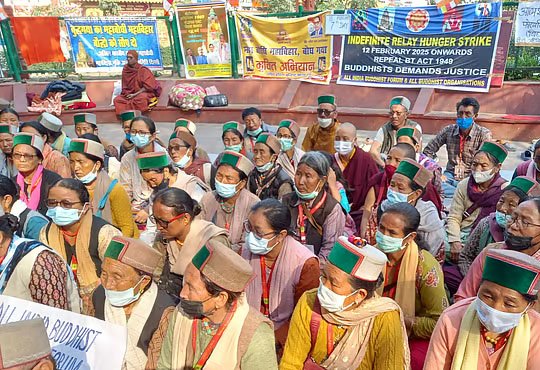Bodh Gaya, India – February 24, 2025 – A significant protest erupted at the sacred Buddhist site of Bodh Gaya as Buddhist monks and devotees rallied against what they describe as the growing influence of Brahmanical practices in Buddhist temples. The protests, held within the vicinity of the revered Mahabodhi Temple, have sparked a heated debate over the intersection of religion, power, and cultural identity in India.
The Mahabodhi Temple, one of the holiest Buddhist sites in the world, is where Siddhartha Gautama, the Buddha, is believed to have attained enlightenment. For centuries, the temple has been a focal point of Buddhist spiritual practices. However, recent changes in temple administration and rituals have led to growing tensions among the local Buddhist community, which claims that Brahmanical rituals and customs are being increasingly introduced, sidelining traditional Buddhist practices.
A group of Buddhist monks, led by prominent figures from the International Buddhist Confederation, gathered outside the temple on Friday to voice their concerns. Holding banners that read “Protect Buddhist Identity” and “No Brahmanical Influence in Buddhist Temples,” the protesters chanted slogans calling for the restoration of purely Buddhist rituals and practices.
“We are witnessing an erosion of Buddhist traditions in our sacred space,” said Ven. Tenzin Norbu, a monk from the Tibetan tradition who participated in the protest. “The imposition of Brahmanical rituals, including the use of priestly Brahman pandits for ceremonies, is not only against our beliefs but undermines the very essence of our spiritual heritage.”
The protest is a direct response to a series of controversial changes in temple management and religious practices. According to reports, Brahman priests have been appointed to oversee certain rituals that were traditionally led by Buddhist monks, including those related to offerings and prayers during key religious events. Furthermore, it is alleged that some Brahmanical symbols and rituals, such as the use of sacred fire ceremonies, have begun to overshadow traditional Buddhist practices.
Critics argue that the growing Brahmanical influence is symptomatic of broader societal pressures to blend Hindu and Buddhist practices, a trend that some fear could dilute the distinct identity of Buddhism. Proponents of the changes, however, maintain that these steps are part of an effort to promote interfaith harmony and respect the diversity of India’s religious heritage.
“The goal is to foster unity among different communities. The inclusion of Brahmanical elements is an attempt to acknowledge the diverse spiritual traditions that coexist in this region,” said one temple official, who wished to remain anonymous.
However, the Buddhist community remains divided. While some monks and lay followers support the call for unity, many feel that the fusion of religious practices undermines the integrity of Buddhism, which has always emphasized individual enlightenment and non-ritualistic practices.
The protests at Bodh Gaya have drawn attention to a broader issue of religious domination in India, particularly the historical and ongoing tensions between the Brahmanical traditions of Hinduism and other religious groups, including Buddhism and Dalit communities. The growing influence of Brahmanism in Buddhist spaces is being viewed by some as part of a larger societal push to reassert Brahmanical supremacy.
Local authorities have stepped in to manage the situation, calling for calm and dialogue between the different factions. “We understand the concerns of the Buddhist community and are committed to ensuring that all religious traditions are respected within the temple complex,” said Rajesh Kumar, the district magistrate of Gaya.
As the protest continues to unfold, it remains to be seen how the Buddhist community and temple authorities will navigate the complex issues of religious practice, cultural identity, and interfaith relations in Bodh Gaya, a site of immense spiritual and historical significance.
This ongoing debate has also raised questions about the preservation of Buddhist traditions in the face of growing interfaith and political pressures in modern India.


Leave a Reply